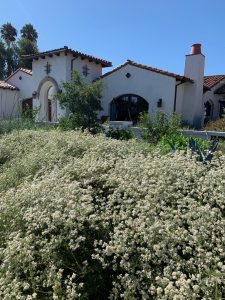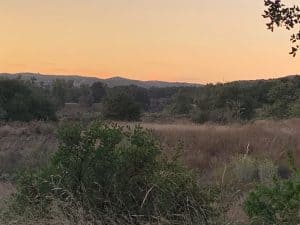It bears repeating. September and May are transitional months; in each, we leave one key season behind to move into the next. In May we get ready to enter into summer, in September we say adios. In September, we may see some very hot days, but the effect on plants is less severe than that of classic summer heat. First, the sun is lower in the sky. Second, the days are shorter… and third, the nights will be getting cooler.
From our 2018 posting, here is our unique “Six Season Calendar for the California Natural Garden”:
Pre-Fall – September – bye-bye hot and dry, hello cool and moist, transition month.
Fall – October, November – many garden tasks, planting season begins, fall flowers.
Winter – December, January – enjoy the short days, migratory birds, bundle up, pray for rain.
Spring – February, March, April – enjoy abundant flowers, birds, butterflies, life! good planting season, periodic rains, more life! celebration of life.
Pre-Summer – May – bye-bye cool and moist, hello hot and dry, transition month.
Summer – June, July, August – enjoy the long days, judicious watering, summer bloom, and a huge diversity of pollinators on buckwheats screaming in full bloom during the intense heat of the hottest day.
During this key transitional month, garden tasks are simple. Do them correctly and your intro to fall which is an intro to winter will be seamless and elegant. Be sure to read last year’s September post found here, as the information is pertinent again now.
 Watering
Watering
You need to water as if it will never rain again. Don’t be tempted to hold off and wait for our first water-from-the sky event in the fall/winter season. It is too early to be that hopeful. This month day lengths are incrementally decreasing, temperatures are being moderated, but the soil is still warm. With proper watering, many native species will start to grow again… sort of a “second spring,” if you will.
Here’s the key. Apply water so that it will penetrate 14-18” deep. On an established garden, you do this every 3-4 weeks, depending on your location and soil type. In summer, you do this during a cool spell, in the wee hours of the morning. This Deep Soak irrigation should provide the equivalent of a rain event delivering 1-1.5” precipitation. With a sprinkler system, use 2 or 3 start times, perhaps on 2 or 3 consecutive mornings, or another option is to use 2 start times on the same day, separated by a 2-3 hour pause. In this way, your sprinkler system is simulating rain showers. This is the healthiest way to water because it allows the soil to “breathe” air between showers.
The simple math: For most water-efficient systems you will apply 1-1.5” of water with a total run-time of 1.5-2 hours, divided equally into 2-3 sprinkles with separate start times, i.e.; 3 irrigations at 35 minutes each equalling 1 hour 45 minutes total sprinkler run. Assuming your system delivers .75” per hour, you will have applied 1.3” of water. Perfect.
Related to Watering
OK, you’ve got your Deep Soak figured out. Now comes the fun part… Refreshing Sprinkles. You do these with your garden hose (or sprinklers, but it’s more fun with the hose), early evening, or at this time of year, early morning, or on some days both. Here’s the trick: In the cool of the morning, or as the day is drawing to a close, you spray down the leaves, plants and soil surface for about 5 minutes, (if in the afternoon, after a hot day you should take a fully clothed shower, feels good), cooling the entire garden down. You are not watering the roots. The water is not going into the soil. But plants absorb water through their leaves as well, and this practice will put you in direct contact with your garden. You can do it a few or several times a week.
Combining these two practices, (Deep Soak and Refreshing Sprinkle) is the best way to water native plants in the dry season. More details can be found here.
Pruning
Not much to do this month. Remove unsightly dead branches or finish your “deadheading,” removing spent flowers or dried seed heads on sunflowers, sages, buckwheats, etc. You can crush up the dried material and spread it as top-dress in a bare area, increasing habitat value. You might even get a few volunteer seedlings!
 Weeding
Weeding
If you are going to grub out summer weeds with a hoe, be sure to carefully remove and discard the seed heads first, so you don’t spread them throughout your whole garden.
Mulching/Topdress
Best to not bring any new material onto the soil surface of an established garden during hot weather. Always encourage the natural accumulation of organic material under your plants in what gardeners call “leaf litter.” I love that term. Puts new meaning into “Don’t Litter”… adding “Unless You’re a Plant.”
Feeding
You may see that “second spring” new growth emerging and feel tempted to fertilize. No rush. Wait for the end of the month at the earliest, October and beyond even better. We recommend all-purpose organic plant food. More on this next month.
Troubleshooting – Varmints, Pests, and Diseases
The soils are still warm and plants may still be susceptible to summer root rot. If plants such as manzanita, coffeeberry, Fremontia, Catalina ironwood, even toyon and Pacific wax myrtle go limp and turn brown, and you can rule out lack of water, (because they are in saturated soil), you can know that it was not per se “too much water” that killed them but more accurately “not enough oxygen.” When free moisture takes up all the pore space in warm soils, some native plants will get root rot. This is why deep infrequent Deep Soaks are best. The roots will be growing is a safe soil zone, 8-18” deep where the temps are consistently cool.
Annual Wildflowers
Don’t sow seeds now unless you want to give the birds expensive food. Wait until rain is a sure bet.
Adding New Plants
You’ve been very patient through summer. September 15 is as close to October as two weeks, so the ideal planting season is here (well, just around the corner). Come on in and see what we’ve got for you for the fall season, coming up right after this transition month, September. yes!
Engage
Inspiration. We all need it and we can all give it to others. But where do we get it? Well, maybe a quiet time at the end of the day, just marveling at how your garden made it through the summer, or a day trip to the backcountry to watch the amazing sunset sky colors (don’t forget to look both west and east), or a quick study in natural beauty – those dry flowers arranged in that pretty vase, the ones you couldn’t bring yourself to toss.
Some of the things that inspire us can be recorded… in a journal, a sketchbook, a song, poetry, pressed flowers, photos, and of course memories. And some are fleeting. That’s why we need new inspiration all the time. Revive the memories, and provide for new ones.
From the Garden,
Mike Evans
Questions? Help is just one call or one email away. Call (949) 728-0685 or email (with pictures if you like) our special helpline: gardenhelp@californianativeplants.com
To get our monthly updates sign up for our eNewsletter at this link here.